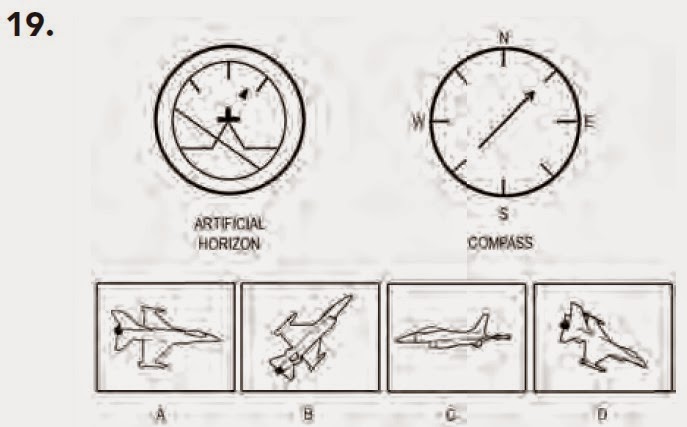Voici les consignes du test en anglais,si vous ne pouvez pas lire les consignes en anglais oubliez l'idée de devenir pilote, l'anglais est la langue de l'aéronautique.
The Instrument Comprehension subtest measures your ability to determine the position of an aircraft in flight by reading instruments showing its compass heading, its amount of climb or dive, and
its degree of bank to right or left. In each test item, the left-hand dial is labeled artificial horizon. The small aircraft silhouette remains stationary in the center of this dial, while the positions of the heavy black line and the black pointer vary with the changes in the position of the aircraft in which the instrument is located.
The heavy black line represents the horizon line and the black pointer shows the degree of bank to right or left. If the aircraft is neither climbing nor diving, the horizon line is directly on the silhouette’s fuselage.
If the aircraft has no bank, the black pointer will point to zero (Dial 1).
If the aircraft is climbing, the fuselage silhouette is seen between the horizon line and the pointer. The greater the amount of climb, the greater the distance between the horizon line and the fuselage silhouette.
If the aircraft is banked to the pilot’s right, the pointer will point to the left of zero (Dial 2).
If the aircraft is diving, the horizon line is between the fuselage silhouette and the pointer. The greater the amount of dive, the greater the distance between the horizon line and the fuselage silhouette.
If the aircraft is banked to the pilot’s left, the pointer will point to the right of zero (Dial 3).
The horizon line tilts as the aircraft is banked. It is always at a right angle to the pointer.
In each test item, the right-hand dial is the compass.
This dial shows the direction in which the aircraft is headed. Dial 4 shows north, Dial 5 is west, and Dial 6 is northwest.
Each item in this test consists of two dials and four silhouettes of aircraft in flight. Your task is to determine which of the four aircraft is closest to the position indicated by the two dials. Remember, you are always looking north at the same altitude as each plane. East is always to the right as you look at the page. (Note: B in Question 2 is the rear view of the aircraft, and B in Question 4 is the front view.) You have nine (9) minutes to complete this subtest.
Questions: 20
Time: 9 minutes























